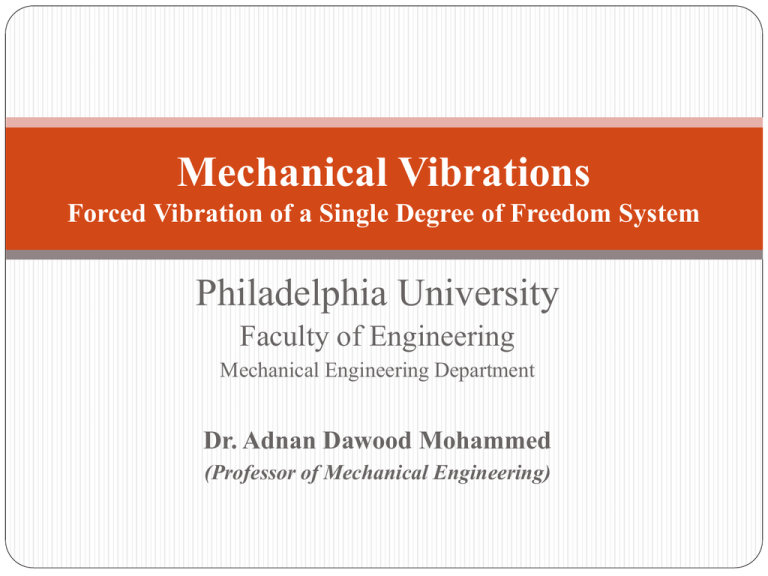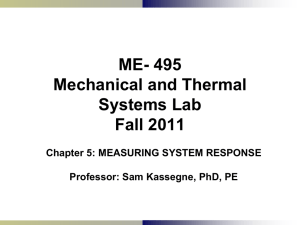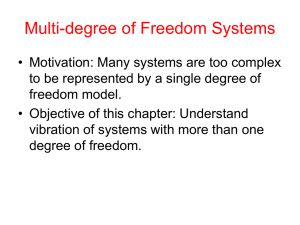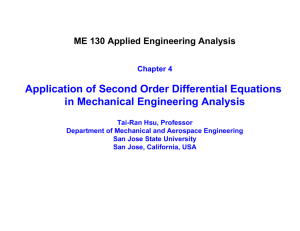Introuction To numerical methods
advertisement

Mechanical Vibrations Forced Vibration of a Single Degree of Freedom System Philadelphia University Faculty of Engineering Mechanical Engineering Department Dr. Adnan Dawood Mohammed (Professor of Mechanical Engineering) Harmonically Excited Vibration Physical system .. . m x c x kx F t Equat ionof mot ion F t is a harmonicforce.It may t akesone of t hefollowingforms: F t Fo sin t F t Fo cost F t Fo e jt Fo is t heamplit udeof force is t hefrequencyof force Harmonically Excited Vibration Consider the form: .. . m x c x kx Fo e jt Equation of motion (1) T his2nd order differential equation is non - homogenuos. Itssolution has two parts 1. Complementary function(T ransientresponse): It is thesolutionfor the homogeneous equation (described in previouschapter).for 1 T hesolution was writtenas : xc (t ) e nt C1 cosd t C2 sin d t 2. P articularintegral(steadystateresponse: It is thesolutionfor the non homogenuosequation.Because theforce(excitation) is harmaonic with frequency we can expect tha t theresponse(solution)is harmonic with thesame frequency. T hesolutioncan be writtenas x p (t) Xe jt , X is called the' steadtystateresponseamplitude' Harmonically Excited Vibration Subst it ut e t hepart icularint egralint oequat ion (1) and solvefor X : X Fo k 2 m jc m c e By writ ing k 2 m jc k 2 2 2 j as , where t an-1 cw is t he" phase 2 k m angle"bet ween Forceand Response. X X e j where X Fo k m c 2 2 2 T herefor t hepart icularint egralcan now be writ t enas x p X e j t , X denot est he" magnit ude"of t he st eady st at eresponseamplit ude. Harmonically Excited Vibration X and may be writ t enas : X Fo k 1 r 2r 2 2 2 , where r is t hefrequencyrat io. n 2r 2 1 r T he t ot alsolut ion(response)for t he equat ion of mot ion(1) is : t an1 x(t ) xc (t ) x p (t ) x(t ) e nt C1 cosd t C2 sin d t X e j t Not e t hatC1 and C2 are const ant st o be derminedfrom knowing t heinat ialcondit ionsof t hemot ion. Harmonically Excited Vibration NOT ES: 1. For theforceform F(t) Fo sin t x p (t ) X sin t 2. For theforceform F(t) Fo cost x p (t ) X cost 3. T ransientresponse( xc (t )) representsa motion t ha t decays with timeand can be neglectedaftera certain time. 4.St eady stateresponse( x p (t )) is a harmonicmotion with constant amplitudeand frequency. 5. T he term X st Fo is usually called the" staticdeflection( st ). T heratio k is usually called the" Magnification Factor(M)". M 1 1 r 2r 2 2 2 Damped Forced Vibration System Graphical representation for Magnification factor M and ϕ. Damped Forced Vibration System Notes on the graphical representation of X. For ζ = 0 , the system is reduced and becomes un-damped. for any amount of ζ > 0 , the amplitude of vibration decreases (i.e. reduction in the magnification factor M). This is correct for any value of r. For the case of r = 0, the magnification factor equals 1. The amplitude of the forced vibration approaches zero when the frequency ratio ‘r’ approaches the infinity (i.e. M→0 when r → ∞) Damped Forced Vibration System Notes on the graphical representation for ϕ. For ζ = 0 , the phase angle is zero for 0<r<1 and 180o for r>1. For any amount of ζ > 0 and 0<r<1 , 0o<ϕ<90o. For ζ > 0 and r>1 , 90o<ϕ<180o. For ζ > 0 and r=1 , ϕ= 90o. For ζ > 0 and r>>1 , ϕ approaches 180o. Harmonically Excited Vibration Variationof displacement withfrequency: We have: X Fo k 1 r 2r 2 2 is thes.s responseamplitude 2 1. At low frequency(r 0) then X Fo which means thedisplacement k is Stiffness control. 2. At high frequency(r 1) then X Fo which means thedisplacement 2 m is Mass control. Fo which means thedisplacement 2k is Dampingcontrol.(for small ) 3. At resonance(r 1) then X Harmonically Excited Vibration Frequency of Maximumamplitude: T hes.s responseamplitudecan be writtenas : -1/2 Fo 2 2 2 X 1 r 2r k d X is maximumwhen ( X ) 0 dr T hisconditiongives : X is maximumwhen r 1 2 2 which is known as a n Resonance Frequency, i.e res n 1 2 2 Forced Vibration due to Rotating Unbalance Unbalance in rotating machines is a common source of vibration excitation. If Mt is the total mass of the system, m is the eccentric mass and is the speed of rotation, the centrifugal force due to unbalanced mass is meω2 where e is the eccentricity. The vertical component (meω2 sin(ωt) is the effective one because it is in the direction of motion of the system. The equation of motion is: .. . M t x c x kx m e 2 sin t Forced Vibration due to Rotating Unbalance X X m e 2 k 1 r 2 2 2 r , or 2 m e 2 M r t 1 r 2 2 2 r 2 and 2 r t an 2 1 r 1 T heplot sof X and are shown in t hefigure below Transmissibility of Force If t hedeflect ionof foundat ionis neglugible, t hen t heforce t ransmited t t o t hefoundat ionis Ftr e jt kx cx Assume harmonicmot ion (k jc) Fo Ftr (k 2 m) jc i.e, x Xe jt define T R F as t heForceT ransmissibilit y, T R F TRF 1 (2r ) 2 (1 r 2 ) (2r ) 2 , 2r t an (1- r 2 ) 1 Ftr Fo Transmissibility of displacement (support motion) Physical system: The forcing function for the base excitation .. . . Mathematical model: m x c x y k x y 0 Transmissibility of displacement (support motion) Substitute the forcing function into the math. Model: .. . m x c x kx kY sin t cY cost A sin t Where: AY k 2 2 c c tan k Assume x(t) Xsint 1 Displacement T ransmissibility(T Rd ) (Harmonic motion) X Y k 2 c 2 2 k m c 2 2 2r 2 1 r tan1 1 2r 2 1 r 2r 2 2 2 Transmissibility of displacement (support motion) Graphical representation of Force or Transmissibility ((TR) and the Phase angle ( Displacement Example 3.1: Plate Supporting a Pump: A reciprocating pump, weighing 68 kg, is mounted at the middle of a steel plate of thickness 1 cm, width 50 cm, and length 250 cm. clamped along two edges as shown in Fig. During operation of the pump, the plate is subjected to a harmonic force, F(t) = 220 cos (62.832t) N. if E=200 Gpa, Find the amplitude of vibration of the plate. Example 3.1: solution The plate can be modeled as fixed – fixed beam has the following stiffness: 192EI l3 3 1 1 But I bh3 50x10 2 1x10 2 41.667x109 m 4 12 12 192 200x109 41.667x109 So, k 102,400.82 N / m 2 3 250x10 k The maximum amplitude (X) is found as: -ve means that the Fo 220 X 1.32487m m response is out of 2 k m 102,400.82 6862.832 phase with excitation Example 3.2: Find the total response of a single-degree-of-freedom system . with m = 10 kg, c = 20 N-s/m, k=4000 N/m, xo = 0.01m and x=o0 when an external force F(t) = Fo cos(ωt) acts on the system with Fo = 100 N and ω = 10 rad/sec . Solution a. From the given data n k m 4000 20rad / s 10 c 20 0.05 2mn 21020 d 1 2 n d 1 0.052 20 d 19.975rad / s r 10 0.5 n 20 Example 3.2: Solution F 100 st o 0.025 m k 4000 X st 1 r 2r 2 2 0.3326 m 2 2 r o 3 . 814 2 1 r tan1 Total solution: X(t) = X c (t) + X p(t) x (t) Ae x (t) Ae - n t cos( n t - ) X cos( t - 0.066) - 0.05*20t cos(19.97t - ) 0.3326cos(20t - 0.066) at t 0, xt 0.01m 0 Acos 0.3326* cos0.066 Acos 0.33187 (1) -t x (t) Ae cos(19.97t- ) 0.3326cos(20t - 0.066) -t -t x (t ) Ae * -19.97sin(19.97t- ) A cos(19.97t- ) * (-t)e 0.3326* 20sin(20t - 0.066) at t 0, x t 0 0 19.97 A sin 0.438, A sin 0.0219 (2) From (1) and (2) 0.066rad and A -0.3325 -t x(t) -6.64e cos(19.97t- 0.066) - 0.3326cos(20t - 0.066)










